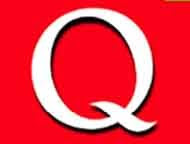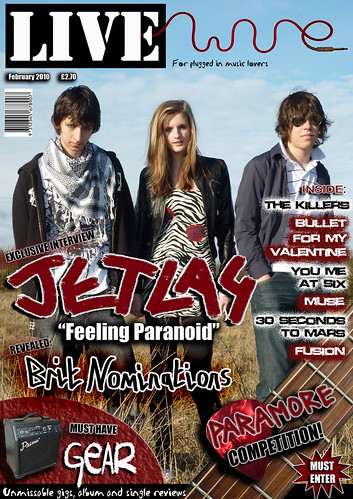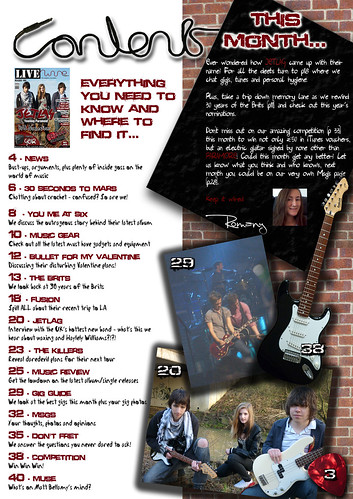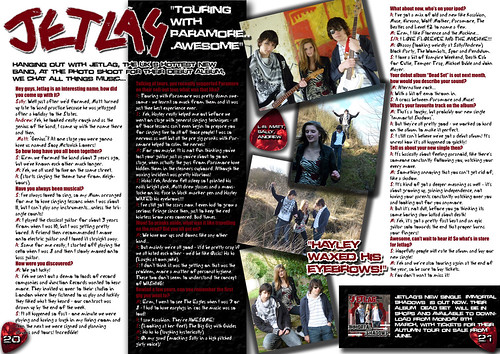 1 – The Title of the Magazine
1 – The Title of the Magazine For the masthead of my magazine I used “Stencil Std” as my font for the “LIVE” section and a photo of a guitar amp wire spelling “wire” which I’d manipulated using Photoshop for the other section. I stuck to the colours black, white and red because these colours seem to be the classic colours associated with rock – the genre of my magazine. The “LIVE” section of my masthead follows the codes and conventions of some existing magazines. For example it could be compared to “Kerrang!”, in the sense that this masthead is also bold, white and surrounded by a black box:-

The masthead for “Q” is also surrounded by a box and uses the colours red and white:-

However, the masthead for my magazine does also challenge the codes and conventions of real magazines as the “wire” section is very thin and wavy. This challenges the conventions of magazines because mastheads are normally thick and bold. In spite of this, I think my masthead works because it combines the conventional and unconventional features of a masthead, making it unique and therefore more eye-catching and memorable.
2- Mis-en-scene of imagesI think the mis-en-scene of my images follow the codes and conventions of magazines. This is because, I used a variety of settings for my photos ranging from a graffitied underpass to a deserted wasteland, similar to those used in magazines like “Kerrang!” and “Rock Sound”. These landscapes fit in well with the concept of my magazine because they reflect the essence of rock that I was trying to capture. In addition to this, the majority of my images follow the conventions of magazines by displaying the band as moody, serious and not caring what others think. This is portrayed by their mode of address – they’re looking directly at the camera in most of the photos.
3- Costumes and Props The costumes and props used throughout “LIVEwire” are conventional. This is because the band in my magazine wore costumes which included black eyeliner, ripped jeans, leather jackets and aviator sunglasses. All of these items could be found in real music magazines. In addition to this, the props features are commonly used in existing magazines as they are staples of the rock star image - for example the black electric guitar.
4 – People The people featured in my magazine are quite unconventional. This is because they’re quite young and not as extreme or obscure in their appearance as some bands featured in rock magazines. In addition to this, most bands in real magazines seem to include at least four or five male members. Therefore I’ve been unconventional by featuring a band which consists of one female and two males. However, because my target audience is teenagers with a slight bias towards females in the way my magazine is written, I think that the unconventional choice of people in relation to existing magazines, won’t be an issue. This is because by using teenagers on the front of my magazine and featuring a girl as the main singer, the audience will be able to relate and aspire to be like them; the target audience are more likely to be interested in a teenage band than a middle-aged radical band.
5- Title Font and Style I created the title “Jetlag” by using a brush tool in photoshop and then adding an outer glow and drop shadow to it. I think my title is slightly unconventional in the sense that the letters are positioned at varying angles, whereas real magazines tend to keep their headlines in a straight line. However I feel that this will appeal more to my teenage audience because of its visual impact. On the other hand the title is conventional in the sense that it has the largest font size on the page, apart from my masthead, and it’s bold and stands out. In addition to this, the way the title looks worn away and slightly rough is similar to real music magazines like the ones I analysed at the start of the project.
6- Written Content The written content of my magazine follows the codes and conventions of a real music magazine by covering similar topics in the questions. For example, it asks about the bands first concert, what’s on their own ipod, how they came up with their name, what their new album is about, touring experiences etc. All of these topics could be found in a real music magazine aimed at teenagers and young adults. In addition to this, the standfirst follows conventions by introducing the band at the start of the interview. Furthermore, the editor’s letter featured on the contents page has a chatty, familiar mode of address which is conventional.
7- Music Genre And How Your Magazine Suggest It The main genre of my music magazine is rock with indie influences. This is quite clear throughout my magazine because of the props on display. For example, I used a plectrum as the page number, a guitar fret on the front cover, an electric guitar on the contents page and a guitar amp wire for part of the masthead. In addition to this, the bands listed on the front cover and in the contents page are of the same genre. As well as this, the use of black, white and red throughout my magazine (classic rock colours) and the mis-en-scene of the images emphasises that “LIVEwire” is a rock magazine. Real music magazines suggest their genre by the mis-en-scene of their images and the bands included, therefore my magazines follows the codes and conventions.
8 – Layout The layout of my magazine is mainly conventional. This is highlighted on the double page spread which displays an interview in columns beneath a standfirst and title. In addition to this, the photos are arranged at angles with quotes dotted on the page. As well as this, my front cover follows layout conventions by having the masthead at the top of the page, a list of bands down the right-hand side and a main headline across the middle. However the positioning of my barcode is unconventional because it’s displayed beneath the masthead rather than in the usual bottom right-hand corner.
9 – Contents Page My contents page contains elements that follow the codes and conventions of existing music magazines. For example it features an editorial which includes a handwritten signature and a photo of the editor. However, in comparison to the contents pages I analysed at the start of this project, the layout of my contents is not as regimented and grid-like as “Kerrang!”, thus making it slightly unconventional. In spite of this, I think that the arrangement of the photos, use of a brick wall and quirky fonts would appeal to the teenage audience more than a uniformed layout.


















